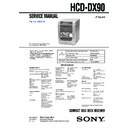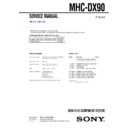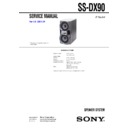Sony HCD-DX90 / MHC-DX90 Service Manual ▷ View online
SERVICE MANUAL
COMPACT DISC DECK RECEIVER
E Model
SPECIFICATIONS
HCD-DX90
Ver 1.0 2001.04
9-873-882-11
Sony Corporation
2001D0500-1
Home Audio Company
C
2001.4
Shinagawa Tec Service Manual Production Group
HCD-DX90 is the tuner, deck, CD and
amplifier section in MHC-DX90.
amplifier section in MHC-DX90.
Model Name Using Similar Mechanism
HCD-BX9/DX9
CD Mechanism Type
CDM58-K2BD38
Base Unit Type
BU-K2BD38
Optical Pick-up Type
KSM-213DAP
Model Name Using Similar Mechanism
NEW
Tape Transport Mechanism Type
TCM-230AWP11
CD
SECTION
TAPE DECK
SECTION
Inputs
MD/VIDEO (AUDIO) IN: voltage 450 mV/250 mV,
(phono jacks)
MD/VIDEO (AUDIO) IN: voltage 450 mV/250 mV,
(phono jacks)
impedance 47 kilohms
MIC:
sensitivity 1 mV,
(phone jack)
impedance 10 kilohms
Outputs
PHONES:
PHONES:
accepts headphones of 8
(stereo mini jack)
ohms or more
FRONT SPEAKER:
accepts impedance of 4 to
16 ohms
16 ohms
CD player section
System
Compact disc and digital
audio system
audio system
Laser
Semiconductor laser
(
(
λ
=780nm)
Emission duration:
continuous
continuous
Laser output
Max. 44.6
µ
W*
*This output is the value
measured at a distance of
200 mm from the
objective lens surface on
the Optical Pick-up Block
with 7 mm aperture.
measured at a distance of
200 mm from the
objective lens surface on
the Optical Pick-up Block
with 7 mm aperture.
Frequency response
2 Hz – 20 kHz (
±
0.5 dB)
Wavelength780 – 790 nm
Signal-to-noise ratio
Signal-to-noise ratio
More than 90 dB
Dynamic range
More than 90 dB
CD OPTICAL DIGITAL OUT
(Square optical connector jack, rear panel)
Wavelength660 nm
Output Level
(Square optical connector jack, rear panel)
Wavelength660 nm
Output Level
–18 dBm
Tape player section
Recording system
4-track 2-channel stereo
Frequency response
40 – 13,000 Hz (
±
3 dB),
(DOLBY NR OFF)
using Sony TYPE I
cassette
40 – 14,000 Hz (
cassette
40 – 14,000 Hz (
±
3 dB),
using Sony TYPE II
cassette
cassette
Tuner section
FM stereo, FM/AM superheterodyne tuner
FM tuner section
Tuning range
87.5 – 108.0 MHz
Antenna
FM lead antenna
Antenna terminals
75 ohm unbalanced
Intermediate frequency
10.7 MHz
AM tuner section
Tuning range
531 – 1,602 kHz
(with the interval set at 9
kHz)
530 – 1,710 kHz
(with the interval set at 10
kHz)
(with the interval set at 9
kHz)
530 – 1,710 kHz
(with the interval set at 10
kHz)
Antenna
AM loop antenna
Antenna terminals
External antenna terminal
Intermediate frequency
450 kHz
Amplifier section
The following measured at AC 120, 220, 240V
50/60 Hz
DIN power output (rated) 220 + 220 watts
50/60 Hz
DIN power output (rated) 220 + 220 watts
(4 ohms at 1 kHz, DIN)
Continuous RMS power output (reference)
300 + 300 watts
(4 ohms at 1 kHz,
10% THD)
(4 ohms at 1 kHz,
10% THD)
General
Power requirements
120 V, 220 V or 230 - 240
V AC, 50/60 Hz
Adjustable with voltage
selector
V AC, 50/60 Hz
Adjustable with voltage
selector
Power consumption
300 watts
Dimensions (w/h/d)
Approx. 280 x 360 x 425
mm (11
mm (11
x 14
3
/
16
x 16
11
/
16
in.)
Mass :
Approx. 11 kg
(24 lb. 5 oz)
(24 lb. 5 oz)
Supplied accessories:
AM loop antenna (1)
Remote commander (1)
Batteries (2)
FM lead antenna (1)
Front speaker pads (8)
Remote commander (1)
Batteries (2)
FM lead antenna (1)
Front speaker pads (8)
Design and specifications are subject to change
without notice.
without notice.
2
HCD-DX90
This appliance is classified as a CLASS 1 LASER product. The
CLASS 1 LASER PRODUCT MARKING is located on the rear
exterior.
CLASS 1 LASER PRODUCT MARKING is located on the rear
exterior.
Laser component in this product is capable
of emitting radiation exceeding the limit for
Class 1.
of emitting radiation exceeding the limit for
Class 1.
CAUTION
Use of controls or adjustments or performance of procedures
other than those specified herein may result in hazardous radiation
exposure.
other than those specified herein may result in hazardous radiation
exposure.
Notes on chip component replacement
• Never reuse a disconnected chip component.
• Notice that the minus side of a tantalum capacitor may be
• Notice that the minus side of a tantalum capacitor may be
damaged by heat.
Flexible Circuit Board Repairing
• Keep the temperature of soldering iron around 270˚C
during repairing.
• Do not touch the soldering iron on the same conductor of the
circuit board (within 3 times).
• Be careful not to apply force on the conductor when soldering
or unsoldering.
NOTES ON HANDLING THE OPTICAL PICK-UP
BLOCK OR BASE UNIT
BLOCK OR BASE UNIT
The laser diode in the optical pick-up block may suffer electrostatic
break-down because of the potential difference generated by the
charged electrostatic load, etc. on clothing and the human body.
During repair, pay attention to electrostatic break-down and also
use the procedure in the printed matter which is included in the
repair parts.
The flexible board is easily damaged and should be handled with
care.
break-down because of the potential difference generated by the
charged electrostatic load, etc. on clothing and the human body.
During repair, pay attention to electrostatic break-down and also
use the procedure in the printed matter which is included in the
repair parts.
The flexible board is easily damaged and should be handled with
care.
NOTES ON LASER DIODE EMISSION CHECK
The laser beam on this model is concentrated so as to be focused on
the disc reflective surface by the objective lens in the optical pick-
up block. Therefore, when checking the laser diode emission,
observe from more than 30 cm away from the objective lens.
the disc reflective surface by the objective lens in the optical pick-
up block. Therefore, when checking the laser diode emission,
observe from more than 30 cm away from the objective lens.
SAFETY-RELATED COMPONENT WARNING!!
COMPONENTS IDENTIFIED BY MARK
0
OR DOTTED LINE WITH
MARK
0
ON THE SCHEMATIC DIAGRAMS AND IN THE PARTS
LIST ARE CRITICAL TO SAFE OPERATION. REPLACE THESE
COMPONENTS WITH SONY PARTS WHOSE PART NUMBERS
APPEAR AS SHOWN IN THIS MANUAL OR IN SUPPLEMENTS
PUBLISHED BY SONY.
COMPONENTS WITH SONY PARTS WHOSE PART NUMBERS
APPEAR AS SHOWN IN THIS MANUAL OR IN SUPPLEMENTS
PUBLISHED BY SONY.
TABLE OF CONTENTS
1. SERVICE NOTE
······························································· 3
2. GENERAL
·········································································· 4
3. DISASSEMBLY
3-1.
Disassembly Flow ······························································ 6
3-2.
Upper Case (Top) ······························································· 7
3-3.
Loading Panel Assy ···························································· 7
3-4.
Front Panel Section,
CD Mechanism Deck (CDM58-K2BD38) ························· 8
CD Mechanism Deck (CDM58-K2BD38) ························· 8
3-5.
Tape Mechanism Deck (TCM-230AWP11) ······················· 8
3-6.
Panel Board ········································································ 9
3-7.
Trans Board ········································································ 9
3-8.
MAIN Board, AMP Board ··············································· 10
3-9.
Leaf SW Board, Head (A) Board, Head (B) Board ·········· 10
3-10. Base Unit (BU-K2BD38) ················································· 11
3-11. Driver Board, Motor Board, Sensor Board ······················ 11
3-11. Driver Board, Motor Board, Sensor Board ······················ 11
4. TEST MODE
···································································· 12
5. MECHANICAL ADJUSTMENTS
····························· 16
6. ELECTRICAL ADJUSTMENTS
······························· 16
7. DIAGRAMS
7-1.
Circuit Boards Location ··················································· 21
7-2.
Block Diagrams ································································ 22
7-3.
Printed Wiring Board – BD Section – ······························ 24
7-4.
Schematic Diagram – BD Section – ································· 25
7-5.
Printed Wiring Board – Main Section – ··························· 26
7-6.
Schematic Diagram – Main (1/3) Section – ····················· 27
7-7.
Schematic Diagram – Main (2/3) Section – ····················· 28
7-8.
Schematic Diagram – Main (3/3) Section – ····················· 29
7-9.
Printed Wiring Board – Power AMP Section – ················ 30
7-10. Schematic Diagram – Power AMP Section – ··················· 31
7-11. Printed Wiring Board – Panel Section – ··························· 32
7-12. Schematic Diagram – Panel Section – ····························· 33
7-13. Printed Wiring Board – Leaf SW Section – ···················· 34
7-14. Schematic Diagram – Leaf SW Section – ························ 35
7-15. Printed Wiring Board – Driver Section – ························· 36
7-16. Schematic Diagram – Driver Section – ···························· 37
7-17. Printed Wiring Board – Trans Section – ··························· 38
7-18. Schematic Diagram – Trans Section – ····························· 39
7-19. IC Pin Function Description ············································· 40
7-20. IC Block Diagrams ··························································· 42
7-11. Printed Wiring Board – Panel Section – ··························· 32
7-12. Schematic Diagram – Panel Section – ····························· 33
7-13. Printed Wiring Board – Leaf SW Section – ···················· 34
7-14. Schematic Diagram – Leaf SW Section – ························ 35
7-15. Printed Wiring Board – Driver Section – ························· 36
7-16. Schematic Diagram – Driver Section – ···························· 37
7-17. Printed Wiring Board – Trans Section – ··························· 38
7-18. Schematic Diagram – Trans Section – ····························· 39
7-19. IC Pin Function Description ············································· 40
7-20. IC Block Diagrams ··························································· 42
8. EXPLODED VIEWS
8-1.
Main Section ····································································· 45
8-2.
Panel Section ···································································· 46
8-3.
Main Board Section ·························································· 47
8-4.
CD Mechanism Deck Section (CDM58-K2BD38) ·········· 48
8-5.
Base Unit Section (BU-K2BD38) ···································· 49
8-6.
Tape Mechanism Deck Section-1 (TCM-230PWR11) ····· 50
8-7.
Tape Mechanism Deck Section-2 (TCM-230PWR11) ····· 51
9. ELECTRICAL PARTS LIST
······································· 52
3
HCD-DX90
SECTION 1
SERVICE NOTE
1
Cut the thirteen melted-connection points with a cutting plier.
2
panel board
Screw hole
Attach the panel board with
eleven screws (
eleven screws (
+BVTP 2.6
×
8 )
after the board is removed once.
Do not tighten the screws excessively.
Do not tighten the screws excessively.
Note for installing the panel board
Hot melt
4
HCD-DX90
SECTION 2
GENERAL
1
DISC SKIP EX-CHANGE button
2
DISC 1 button and indicator
3
DISC 2 button and indicator
4
DISC 3 button and indicator
5
Z OPEN/CLOSE button
6
EDIT, TUNER MOMERY button
7
PLAY MODE, STEREO/MONO button
8
REPEAT, DOLBY NR button
9
DIRECTION knob
q;
SURROUND button
qa
VOLUME knob
qs
PHONES jack
qd
ENTER button
qf
REC PAUSE/START button and indicator
qg
CD SYNC HI-DUB button
qh
LOOP button
qj
MIC jack
qk
MIC LEVEL knob
ql
V-GROOVE button and indicator
w;
CURSOR button and indicator
wa
GROOVE button
ws
EQ EDIT button
wd
SPECTRUM button
wf
DISPLAY button
wg
?/1 button and indicator
wh
TUNER/BAND button
wj
MD (VIDEO) button
wk
gG button
wl
> + button
e;
X button
ea
– . button
es
x button
ed
TAPE A/B button
ef
CD button
eg
Function indicator
eh
m/M knob
1
2 3 4
5
6
7
8
qa
qs
qd
qf
qg
qh
w;
ws
ed
ef
wh
wj
eh
wk
wl
e;
ea
9
q;
wa
ql
wd
wf
wg
es
qk
qj
eg
LOCATION OF CONTROLS



